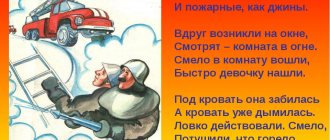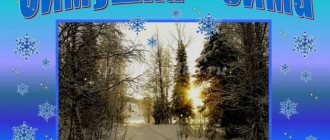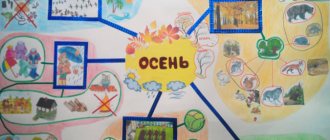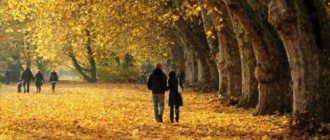Summary of a lesson on speech development in the middle group “This amazing water”
Anastasia Shokhina
Summary of a lesson on speech development in the middle group “This amazing water”
Municipal preschool educational institution
Combined kindergarten No. 31
Lesson notes
on speech development in the middle group
"This amazing water "
Program content: Introduce children to the properties of water (taste, color, smell, fluidity)
. Clarify its meaning for all living things.
— consolidate children’s knowledge about the benefits of water for all life on earth.
Developmental:
- develop curiosity , observation, logical thinking, speech; introduce words into children’s active vocabulary: liquid, colorless, transparent, tasteless.
— develop skills in conducting experiments, observing the necessary safety measures.
- develop the ability to work in a team,
- cultivate a caring attitude towards water.
Game (surprise moment)
.
Verbal (conversations, teacher’s story, search questions)
.
Reading stories and fairy tales of an educational nature.
Experiments (turning snow into water)
.
Preparation of an exhibition of children's works “Our wonderful droplets”
.
- empty glasses and glasses of water (according to the number of children,
-sugar on plates (according to the number of children,
- cocktail straws (according to the number of children,
- napkins (according to the number of children,
Water is the basis of life
All living things are 75% water. This is the most necessary element of living nature. Water constantly circulates between the seas, atmosphere and land, creating conditions in which life can exist and develop.
Water, at first glance the simplest chemical compound, is the basis of life on Earth. Water transports heat, dissolves and transports colossal masses of chemicals and elements, destroys and redistributes rocks, forms landforms, and even participates in the formation of minerals. In addition, water is involved in a number of meteorological phenomena, such as precipitation, fog, clouds. It is involved in the creation of currents, waves, movement of river beds and the formation of reservoirs. It is also a living environment for many organisms.
A person can live without water for only a few days. For the normal functioning of all organs, a person needs at least 1.5 liters of water per day. Water delivers nutrients to the body's cells and carries away waste products. In addition, water is involved in the processes of thermoregulation and human respiration.
Under the rays of the Sun, water evaporates from reservoirs and rises into the air. There, droplets of water collect in clouds and clouds and fall to the ground in the form of rain or snow, which turns into water. It is absorbed into the earth and again returns to the seas, rivers and lakes. And everything starts all over again. the water cycle occurs in nature.
Summary of GCD “What is water needed for” in the middle group
Sumarokova Olga
Summary of GCD “What is water needed for” in the middle group
Synopsis for the presentation “ What is water ?”
Goal: to form in children an idea of water as a vital resource for all living things; expand knowledge about the basic properties of water.
— Expand children’s understanding of the properties of water: water is a liquid ,
— Clarify children’s knowledge about the purpose of water in our lives;
— Develop cognitive interest and activity of children in the process of activity;
— Develop mental operations: comparison, generalization, the ability to analyze, the ability to reason, stimulate independent formulation of conclusions;
- Develop coherent speech,
— Foster respect for water;
Methods and techniques: 1.Game: surprise moment (exit of the “scientist”
). 2. Visual: diagrams, symbols, viewing a presentation.
Three states of water
Substances, depending on their freezing, melting and boiling temperatures, can be found in nature in three states of aggregation - solid , liquid and gaseous . Water freezes at 0°C and boils at 100°C.
In everyday life, we can encounter water in any of its three states, and its form is constantly changing. Liquid water evaporates and turns into a gaseous state - water vapor. It condenses and turns into liquid. At sub-zero temperatures, water freezes and turns into solid ice.
If we place table salt crystals in a vessel with water, we will be able to observe how the amount of solid substance gradually decreases. At the same time, water acquires new properties: it acquires a salty taste, density and freezing point change. The resulting liquid can no longer be called water, it is a solution. Intermolecular bonds arise between salt and water molecules, due to which salt molecules are detached from the surface of the crystal.
Progress of the lesson:
Introduction to the game situation, preparing children for the topic of the lesson.
- Hello guys! I came to visit you, my name is Scientist, and today I will tell you about one of the greatest riches of our planet!
SLIDE No. 1 (presentation title)
SLIDE No. 2 (Listen to the riddle, after guessing, click on the cloud and the correct answer will appear with the sound of water)
And I can be glass!
– Guess what we’re going to talk about today? We will talk about water. I want to talk about the great miracle - water, in order to understand how unique it is.
- Let's listen to a nursery rhyme about water.
SLIDE No. 3 (listen to the nursery rhyme, click on the picture and listen to the nursery rhyme)
- Here are some funny poems about water to make washing more fun for children.
– Tell me, please, why do people need water ?
SLIDES No. 4 (when you click on the drop, pictures appear)
(A person drinks water, washes, cooks)
– But not only humans need water ! Let's see who else needs water .
SLIDE No. 5 (when you click on the drop, pictures appear)
( Water is needed by animals , insects, birds, plants)
.
— Guys, who else can’t live without water, for whom water is home ?
Water is not only the life force for all life on earth, water is necessary for water and underwater transport. For travel and exploration of the seas and oceans and their depths.
- Let's play with you and put together a mosaic. Attention to the screen!
SLIDE No. 7. Game “Assemble the mosaic”
(by clicking on the pieces of the mosaic, they are assembled into one picture)
- Guys, let's take a look and remember in what states water can be found in nature .
SLIDE No. 8. "Three states of water"
.
(by clicking on the arrows in the picture, 3 images appear, indicating the “states of water”
in nature).
«WATER-LIQUID»
.
- It flows from a water tap, flows in a river. This means that it is LIQUID and does not have its own shape.
«WATER IS STEAM»
– The water heats up and turns into steam.
In winter water freezes and becomes solid (ice, snowflakes)
- Look and tell me, where do you think the water ?
SLIDE No. 9. Game “Where the water ”
(when you click on the pictures, the picture enlarges and applause sounds)
(In an icicle, in a pair, in a snowman, in a tap)
.
SLIDE No. 10. Video file (cartoon about water)
.
Attached files:
Summary of direct educational activities in physical education “Why do you need exercise?”
MUNICIPAL BUDGET PRESCHOOL EDUCATIONAL INSTITUTION KINDERGARTEN No. 7 "Rainbow" city of Primorsko-Akhtarsk. APPROVED Head. What is occlusion and why is it needed? What is occlusion and why is it needed? Every year there are more and more children with various vision pathologies. Alone.
“Why do you need finger gymnastics?” In the oral speech of any nation you can find short poems that are accompanied by finger movements. People have long noticed that movements.
Synopsis of direct educational activities on knowledge in the middle group “Why do people need clothes?” Synopsis of direct educational activities on knowledge in the middle group “WHY DO PEOPLE NEED CLOTHES?” Goal: Development of cognitive.
Summary of educational activities for experimentation for children 3–4 years old “Water, water is always needed” Vera Kulagina, teacher, MBDOU “Kindergarten No. 8 “Topolyok” of a combined type. Summary of GCD for experimentation “Water, water is needed.
Abstract of the OOD “Everyone Needs Water” in the senior group Objectives: Show the enormous importance of water for all living beings, consolidate knowledge about natural water sources, expand children’s vocabulary, and educate.
Summary of the lesson of the additional education club “Ekolyata” in the senior group “Who needs water?” Topic: “Who needs water?” Goal: To clarify and expand children’s knowledge about water, its properties, forms and types of water (oceans, seas, rivers, lakes,...
Summary of a lesson on speech development “Who needs water” in the junior group Purpose: To clarify the idea that water is necessary for all living beings (plants, animals, people; people need water for eating, drinking, etc.).
Presentation “What is water for” A presentation in a middle preschool group on the topic “Why is water needed” will clearly show where in our everyday life.
Source
Properties of water
Water is the basis of life. It is the “base” for the good functioning of the human body. There are three known states of water: liquid, gaseous and solid. Consider the following properties of water.
- Transparency. Take two glasses. Pour water into one, milk into the other. Give the baby a bead and offer to lower it into both glasses in turn. The bead can be easily seen in a glass of water, since the water is crystalline and transparent.
- Colorlessness. To confirm, pour water into glasses and paint it with different colors of paint. Leave the water in one glass colorless and transparent, that is, as it was.
- Fluidity. Take plates of various sizes. Pour water into the bottom of a small plate and then into the bottom of a large plate. Place obstacles in the flow path and watch how the water copes with them.
- Without taste and smell. Water has no taste. Do the following experiment: pour water, tea, milk, juice into each of four glasses. Close your baby’s eyes, invite him to try them and describe his feelings: the juice is sour, the tea is sweet, and the water has no taste. But, of course, tasteless water has thousands of flavors and is the most divine nectar. The water doesn't smell. Yes this is true. Pour juices, lemonades, tea into glasses again. Then blindfold your child and ask him to find the water by smell. The baby will find it easily and quickly.
- Accepts any form into which we pour it. Water has no form of its own. To make sure, pour the water into various forms: basins, jugs, vases. It takes the form into which it was poured.
- Dissolution of substances. What dissolves in water? Try dissolving different items in glasses of water: sugar, honey, salt, sand, rice, coffee, beads. It immediately becomes clear that water is not able to dissolve everything.
- Freezing. What is ice? This is water in a solid state. How is it formed? There are two ways. In the first case, the water is cooled to 0°C, this is how cubes are made in the freezer. In the second case, the water vapor freezes and frost appears in the refrigerator.
- Evaporation. Under the sun's rays, water from lakes, seas, rivers, plants, and the human body evaporates. Particles of steam rise into the air, cool, and turn into water droplets. They form clouds together.
- Expansion and contraction of water. When a water bottle freezes, it is likely to burst as the water expands. If you place a flask of water in cold water, it will cool and shrink as it does so.
There are objects that sink in water, and some remain on the surface and float. Dip various things into the water - pebbles, pieces of paper, pine cones, objects made of metal, wood, and watch which ones sink and which ones don’t.
Authors:Ilyina Elena Vitalievna, teacher of preschool educational institution no. 4 “Olympic”, Uglich,
Vagacheva Natalya Nikolaevna, teacher of preschool educational institution No. 4 “Olympiysky”, Uglich
Summary of educational activities on cognitive development (experimental activities) for children of primary preschool age (3-4 years) “With Kapitoshka about the properties of water”
Target:
find out that water has no taste or smell.
Tasks:
Educational:
- consolidate previously studied properties of water: water is liquid, water is transparent;
- introduce children to the properties of water: it has no taste and no smell;
- activate and enrich your vocabulary with new words.
Educational:
- develop in children cognitive activity, the ability to analyze and draw conclusions in the process of experimentation.
Educational:
- develop the ability to work in a team.
Preliminary work:
watching the cartoon "Kapitoshka".
Materials and equipment:
package, jars of water and juice, cups for the number of children with water and juice, a picture with the image of Kapitoshka, cocktail straws, symbols of the properties of water, an audio recording of the song “Kapitoshka”, the game “Drip - drip of drops”.
Progress:
- Introductory part.
Educator
: The guys brought us a package this morning.
Look how beautiful she is! I wonder who sent it to us and what’s inside? (Children's guesses)
Let's open it.
(the song of the group “Wizards of the Yard” “Kapitoshka” sounds, the hero “Kapitoshka” appears from the package)
Kapitoshka
: Hello guys!
Do you recognize me? Who am I? Guys, what do you know about me? (Children's answers)
Kapitoshka:
Today I want to tell you something new about myself. Look what I brought you.
(Two jars are taken from the package: one with water, the other with juice)
Kapitoshka:
What do you think this is?
(Children's answers)
Kapitoshka
: To get acquainted with the new properties of water, let's go to our laboratory.
With Kapitoshka we walk
We want to know everything in the world.
(Children sit at a table with glasses of water on it)
- Main part.
Educator:
Guys, what do you think the water smells like?
(Children's answers)
Teacher:
To find out whether the water smells or not, what do we need to do?
What will help us with this? (Children's answers)
Teacher:
Let's smell the water.
What can we say? (Children's answers)
We will denote this property of water with a symbol (The new property of water, designated by the symbol, is displayed on a magnetic board).
What is shown on the symbol? Why is it crossed out? (Children's answers)
Educator:
Guys, Kapitoshka brought us another jar.
What do you think is in it? (Children's answers)
That's right, guys, it's juice. It will help us find out another property of water.
(Cups of juice are placed on the table)
Educator:
Why do you think I put straws in cups?
(Children's answers)
Yes, we will drink water and juice and find out what they taste like.
(Children try water and juice)
Educator:
How did you feel when you tried the juice?
What is he like? (Children's answers)
What did you feel when you tasted the water?
Does the water have a taste? (Children's answers)
Teacher:
We will also depict this property of water with a symbol
(the new property of water, indicated by the symbol, is displayed on a magnetic board).
Kapitoshka:
Guys, what do you know about me now?
(Children's answers)
Kapitoshka:
Guys, I love playing so much and I want to invite you to play with me.
Game "Drip-drip droplets"
- Final part.
Educator:
Did you guys enjoy working in the laboratory?
What did you like most? (Children's answers)
When Kapitoshka comes to us again, he will tell us a lot of new and interesting things about himself.
Electronic version: Summary of educational activities on cognitive development (experimental activities) for children of primary preschool age (3-4 years) “With Kapitoshka about the properties of water”







